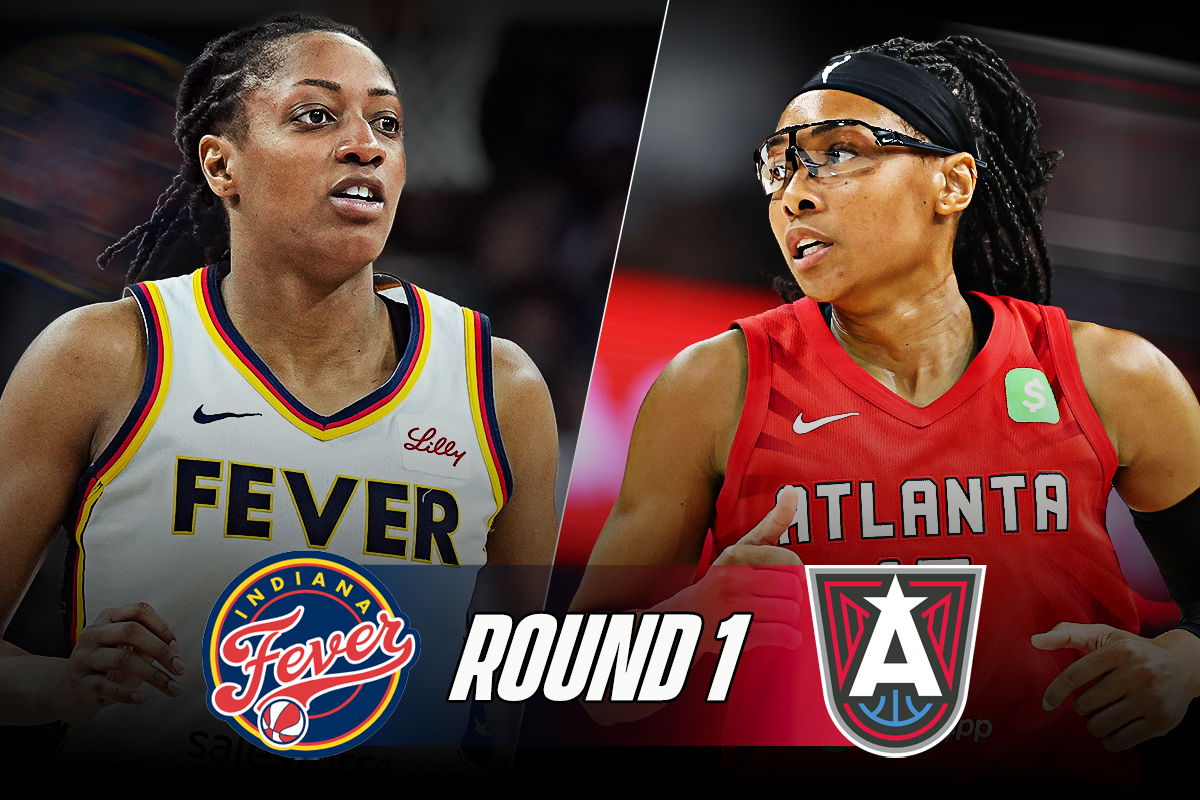
Imago
Credits: Imagn

Imago
Credits: Imagn
The Eastern Conference grudge match is what many are calling this on the internet!
Whether grudge or not, the grit both first-year coaches Stephanie White and Karl Smesko have shown is undeniable. And honestly, nothing could have been more evenly matched for the Fever against a top team, considering the playoff experience at play. Sure, on paper it looks like a three-seed facing a sixth-seed, but as the Fever’s Sophie Cunningham puts it, “Experience wins playoffs!”
ADVERTISEMENT
Article continues below this ad
How we got here: Series context & season recap
The Atlanta Dream enter the 2025 WNBA playoffs as the No. 3 seed with a franchise-record 30-14 regular-season finish, a stunning leap from their 15-25 mark in 2024. They clinched the postseason early and surged late, winning six of their last seven games, capped by an 88-72 upset over the Connecticut Sun to lock in seeding.
Meanwhile, the Caitlin Clark era in Indy brought an end to the Fever’s postseason drought last year. This season might not have gone as expected, but seeded No. 6 at 24-20, Indiana earned back-to-back playoff berths for the first time since 2015-16 despite a brutal injury toll – five season-ending setbacks, including Clark limited to just 13 games. They started hot but dropped 12 of their final 29, leaning on coaching adjustments and hardship contracts to clinch with a 94-65 rout of Washington.
ADVERTISEMENT
Article continues below this ad
At stake is a breakthrough past the first round for both teams, who fell short a year ago. Home-court advantage strengthens Atlanta’s edge in the 1-1-1 format, giving them a prime shot to reach their first Conference Finals since 2013 and stamp themselves as Eastern Conference royalty. For Indiana, this series represents their first chance at a Playoff win since 2015.
Top Stories
Tiger Woods’ Treatment of Caddies Set Him Apart from PGA Tour Rivals, Confesses Steve Williams

Shedeur Sanders Announces What’s Next ‘After’ Landing Browns’ Starting Role Over Dillon Gabriel

Rickie Fowler Comes Clean on Health Issue Stopping Him from Playing PGA Tour Events

NFL Makes Final Punishment Decision on Frankie Luvu After Suspending Commanders LB

Jets GM Confirms Why They Rejected Andy Reid & Chiefs’ Bid For Breece Hall on Deadline Day

Sydney McLaughlin-Levrone Makes a Firm Admission After Being Part of New York City Marathon for Special Cause

And in this intra-conference clash, bragging rights loom large as Atlanta looks to silence the Fever’s dynasty-in-waiting chatter.
Catch the action:
- Sept. 14, Sunday: at Atlanta, 3 p.m. ET, ABC
- Sept. 16, Tuesday: at Indiana, 7:30 p.m., ESPN
- Sept. 18, Thursday: at Atlanta, time TBD, ESPN2 (if necessary)
ADVERTISEMENT
Article continues below this ad
Season series recap
The teams split their four matchups 2-2, with games decided by an average margin of 12.5 points. Atlanta opened with a thrilling 91-90 win on May 20, sealed by Rhyne Howard’s clutch free throw, while Indiana answered two nights later with an 81-76 road win. On June 10, the Dream dominated 77-58 behind Allisha Gray’s 23 points in a game Clark sat out. The Fever responded on July 11 with a 99-82 home victory, powered by Kelsey Mitchell’s 25 points.
In short, Atlanta edged the nail-biters, while Indiana claimed the blowouts.
It’s worth noting, though, that both Fever wins came against versions of Atlanta that looked different from the current roster. Indiana had Caitlin Clark active and even DeWanna Bonner in one matchup, while Sophie Cunningham and Aari McDonald were available as well. That makes the head-to-head record a bit tricky to use as a clear predictor heading into this series.
Playoff history
The playoff history between these two is storied, with meetings in three straight seasons earlier last decade. In 2011, the Dream edged Indiana 2-1 in the Eastern Conference Finals to punch their ticket to the WNBA Finals. A year later, the Fever struck back, winning 2-1 in the same round on their way to the 2012 championship. Their most recent clash came in 2013, when Atlanta swept Indiana 2-0 in the Conference Semifinals before making their last Finals appearance.
Now, after more than a decade apart, the Dream and Fever renew one of the East’s most competitive postseason rivalries.
How they match up: Strengths & weaknesses
Atlanta enters as one of the league’s most balanced teams, ranking second in both offensive and defensive rating. Indiana isn’t far behind on the offensive end, but their defensive efficiency slips to seventh, a gap that could make all the difference in a playoff grind.

Fourth in points per game (84.4), the Dream thrive through a blend of guard creation and paint control, while their defensive edge stems from limiting turnovers (12.5 per game) and leaning on their frontcourt length in half-court sets. Indiana plays faster, scoring at a nearly identical clip (84.9, third) but relying on transition bursts to offset their defensive gaps.
The Fever’s attack leans heavily on Aliyah Boston and Kelsey Mitchell, who combine for nearly half the team’s points. Their bench remains inconsistent, while Atlanta’s rotation runs deeper and steadier. On the glass, the Dream holds the edge, 36.6 rebounds per game, anchored by Brittney Griner and Brionna Jones, compared to Indiana’s 33.4, which ranks ninth.
From distance, Atlanta stretches defenses with volume: 9.6 threes on 28.4 attempts (second in the league). Indiana, meanwhile, opts for fewer looks (24.0) but shoots them at a respectable 34.6%. Paint scoring is firmly Atlanta’s strength, while Indiana relies more on Boston’s mid-range game to generate interior mismatches. The Fever, however, holds one subtle edge: overall shooting. They rank second in field goals made (31.4) on 45.6% accuracy, while Atlanta sits sixth with 30.1 makes on 44.3%.
In other words, Atlanta’s depth and rebounding could suffocate Indiana’s rhythm, but if the Dream start slow, the Fever’s efficiency and pace can swing the game fast.
What could change the game?
Statistical
- Height – Atlanta has a big height advantage. Very few teams including Fever can beat their double big lineup.
- The pace – Indiana’s up-tempo style could generate 20+ fast-break points if they dictate flow, but Atlanta’s slower, half-court execution forces the Fever into tougher, less efficient looks.
- Foul trouble – Both teams draw fouls at similar rates (Atlanta 18.7 FTAs, Indiana 18.0), but Boston’s presence inside could bait Atlanta’s help defenders into hacks. On the flip side, Brittney Griner’s 6’9″ frame could push smaller Fever posts into early foul woes.
- Three-point variance – Atlanta lives on volume while Indiana banks on efficiency. Odyssey Sims has caught fire recently, while Rhyne Howard’s range always looms as a game-breaker. A hot (or cold) night from deep could tilt the series.
- Signature styles & home court – Atlanta thrives on motion offense through Howard/Gray pick-and-rolls and Jones’ interior finishes. Indiana, meanwhile, ranks top five in steals (7.7 per game) and pushes in transition, compared to Atlanta’s 6.8 (11th). Add in the 1-1-1 format, and the Dream’s 16-6 home record looms large against Indy’s 11-11 road mark.
- Aliyah Boston vs. Brionna Jones – Last postseason, Boston dominated Jones (who was playing for the Sun), averaging 16.5 points and 12 boards to all but push her off the floor. Atlanta does have Griner as insurance, but that matchup could swing the paint battle.
- Turnovers – Indiana coughs it up nearly 14 times a game, one of the worst marks in the league, while Atlanta ranks second in ball security. At the same time, Fever is great at forcing turnovers. Possessions may decide this one.
Storylines
- Fever injuries vs. willpower – Despite brutal setbacks, Indiana clawed into the playoffs and now want to prove their resilience wasn’t wasted.
- Griner’s new chase – After more than a decade in Phoenix, Brittney Griner is eyeing her first title with Atlanta, a chance to cap her arrival by launching a new era in the franchise’s history.
- MVP showdown – Allisha Gray’s breakout season puts her in the MVP mix, while Kelsey Mitchell’s scoring punch keeps her in the conversation, too. Both will look to stamp their claim.
- Stephanie White magic – White was Indy’s coach when they had back-to-back playoff seasons.
- Karl Smesko’s historic season – Atlanta’s first-year coach etched his name in the books Monday night against the Sun, guiding the Dream to a WNBA-record 29 wins, the most ever by a rookie head coach (now 30). He’ll be aiming to make this season even more memorable.
Stars and key contributors
One key difference heading into this series: the Dream are finally healthy after early setbacks to Rhyne Howard and Brittney Griner, while Indiana enters almost limping. The Fever have used 16 players this season, with fans jokingly dubbing it the biggest roster in history and even Aliyah Boston herself calling it rare situation. Five season-ending injuries forced their hand – Caitlin Clark (groin), Sophie Cunningham (MCL), Aari McDonald (foot), Sydney Colson (ACL), and Chloe Bibby (knee). Plus, for round 1, Damiri Dantas is also out due to concussion protocol.

Indiana Fever
Kelsey Mitchell (20.2 PPG, 3.4 APG) remains the engine, a three-time All-Star who dropped 25+ twice against Atlanta this season. She averaged 19 points in last year’s playoffs, though it didn’t translate to wins.
Aliyah Boston (15.0 PPG, 8.2 RPG, 3.7 APG), the 2023 Rookie of the Year and three-time All-Star, holds the frontcourt together with near triple-double impact.
Natasha Howard (11.4 PPG, 6.6 RPG) adds championship pedigree and versatility.
X-factors:
- Odyssey Sims (10.3 PPG)
- Aerial Powers (9.0 PPG, 3.5 RPG, 2.4 APG)
- Lexie Hull (7.3 PPG, 4.3 RPG)
Atlanta Dream
Allisha Gray (18.5 PPG, 5.3 RPG, 3.5 APG) drives Atlanta’s attack. She’s scored 20+ in all four Fever matchups this season and has averaged 12.9 points, 4.6 boards in six postseason games in six appearances.
Rhyne Howard (17.5 PPG, 4.5 RPG, 4.6 APG), the 2022 No. 1 pick, stretches defenses with 3.1 triples per game. In two playoff appearances, she’s averaged an amazing 22.5 points.
Brionna Jones (12.8 PPG, 7.3 RPG), a four-time All-Star, adds interior dominance and has been a steady playoff contributor in the past two playoff appearances with Connecticut.
X-factors:
- Jordin Canada (11.2 PPG, 5.7 APG)
- Naz Hillmon (8.6 PPG, 6.2 RPG) is leading the Sixth Woman of the Year
- Brittney Griner (9.8 PPG, 5.2 RPG) brings a championship pedigree and invaluable playoff experience.
Prediction
As much as analysts, fans, and we admire Indiana’s resilience, the injuries leave them undersized and overextended. The Fever could grab one win behind Mitchell and Boston, but sustaining that level without their full rotation feels unlikely.
The Dream, meanwhile, enters with depth, balance, and momentum from a six-game win streak. Beyond the mentioned stars, contributors like Maya Caldwell and Te-Hina Paopao deepen the bench. That, combined with home-court advantage, makes Atlanta the safer bet to advance.
Indiana remains a dangerous opponent, but Atlanta’s ceiling is higher, and we believe its road likely ends in Round 2 against the Las Vegas Aces.
ADVERTISEMENT
ADVERTISEMENT
ADVERTISEMENT
ADVERTISEMENT

